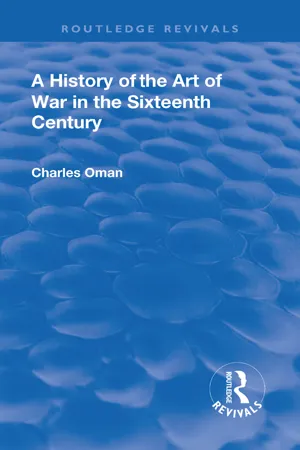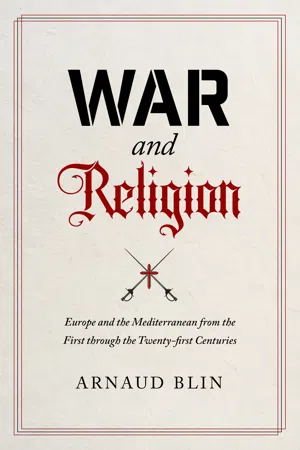History
French Wars of Religion
The French Wars of Religion were a series of conflicts between Catholics and Protestants in France during the 16th century. These wars were fueled by religious and political tensions, resulting in widespread violence and instability. The Edict of Nantes in 1598 granted religious freedom to Protestants, effectively ending the wars and establishing a fragile peace in France.
Written by Perlego with AI-assistance
Related key terms
5 Key excerpts on "French Wars of Religion"
- eBook - ePub
The Struggle for Power in Early Modern Europe
Religious Conflict, Dynastic Empires, and International Change
- Daniel Nexon(Author)
- 2009(Publication Date)
- Princeton University Press(Publisher)
The composite structure of the French state and the significant autonomy enjoyed by key intermediaries—particularly as coercion-wielders—both limited the ability of the Crown to enforce religious ordinances and rendered it vulnerable to the formation of opposing cross-class and cross-regional religious ties. But this was more than a matter of a weak state unable to capitalize on new military-technical developments. Religious differences exacerbated factional conflicts at the French court by raising the stakes of victory and defeat—not only for great nobles but also for ordinary people who might otherwise be relatively indifferent to which noble house dominated the government. Religion provided a categorical difference through which actors yoked together a variety of groups and interests into relatively well-bounded sites for collective mobilization, whether Huguenot or ultra-Catholic in orientation. This process not only allowed sustained, cross-regional resistance to central authorities, but also deprived the royal government of revenue and manpower for use against internal and external threats.The consistent failure of central authorities—or their agents—to broker between opposing confessions and factions also played a key role in the French Wars of Religion. One might argue that these failures were overdetermined: given the weakness of the monarchy, it could not have successfully kept factional conflicts in check even without the added problem of religious differences. But religious cleavages not only made these conflicts much more intractable, they also escalated them beyond a “simple” power struggle at court. The Crown repeatedly proved incapable of making religious concessions that could satisfy Catholics and Huguenots alike. Even Henry IV, who enjoyed a unique position as a bridge between the Huguenots and mainstream Catholics, faced difficulties in his attempts to reconcile the Huguenots to his authority. Violent struggles between the Crown and its Huguenot subjects continued into the Thirty Years’ War.The Wars of Religion and State Formation
We can best understand the impact of the French Wars of Religion on France’s pathway of state formation by considering two features of the civil strife. First, unlike in the Netherlands, France saw a significant Catholic countermobilization against Calvinism. Second, the Huguenot minority in France never made a sustained bid for outright secession. The reasons behind these two aspects of the French Wars of Religion account for how the Reformations accelerated France’s movement along the sovereign-territorial pathway and why religious contestation ultimately favored that pathway in Europe as a whole. - Charles, Sir. Oman(Authors)
- 2018(Publication Date)
- Routledge(Publisher)
BOOK V THE WARS OF RELIGION IN FRANCE (1562–98)Passage contains an image
CHAPTER I GENERAL CONSIDERATIONS: POLITICAL AND MILITARY — THE CATHOLIC AND THE HUGUENOT ARMIEST HERE is, as has often been remarked, an immense difference between the almost continuous strife between the King of Spain and his rebellious subjects in the Netherlands (1568–1607), with which we have presently to deal, and the contemporary struggle in France (1562–98) between the Catholic and Protestant parties, which can be broken up into nine separate civil wars, interrupted by longer or shorter periods of insincere pacification. The fundamental cause of the divergency was that in the Low Countries the Crown was represented by an autolatrous fanatic, equally set on asserting his own will to govern as he pleased, and on extirpating heresy, while in France the Crown meant a family of opportunists, Catherine de Medici and her sons, quite unscrupulous, indeed perfectly ‘amoral,’ whose main object was to survive, and to keep some hold on power during the clash of two contending parties among their subjects. The Queen-Dowager, the dominating spirit at Court during the great part of this period, was no doubt a Catholic so far as personal inclinations went, but she dislikéd the Guise family, the heads of the extreme Catholic party, quite as much as she disliked the turbulent leaders of the Huguenot faction.She desired peace, even peace secured by giving toleration to the Protestants, if by peace alone could the royal power and the survival of her own family be secured. Her name goes down in the history with the red stain of the Massacre of St. Bartholomew smirching it, but it is only fair to her memory to recall the fact that this was a strange and desperate aberration from her general policy, and that half a dozen times she made energetic efforts for peace and toleration, not (of course) because she liked toleration, but because she desired peace for the salvation of her family and the monarchy. Her mental position has been not unjustly compared to that of Elizabeth of England who, like her, sought peace and pursued it, with the most lamentable disregard of pledges and promises, and with a perfect readiness to sacrifice individuals. The English Queen had her difficulties, but they were not complicated by the existence of a family of perverse and degenerate sons, nor of a fierce and reckless feudal noblesse demoralized by fifty years of the old Italian wars of plunder and aggression. Elizabeth’s father and grandfather had worked for her in cutting down such of the ancient English houses as had survived the Wars of the Roses. While she could always count on the support of the bulk of the nation, Catherine de Medici and her sons were only sure of the moderate central faction, the ‘Politiques’ as they were called during the latter part of the period of civil war, who cared more for the safety of the realm and the preservation of the monarchy than for either Catholic Orthodoxy or Protestant Reform. But such men as the Chancellor l’Hôpital were not too common, and appeals to loyalty or national sentiment had only an intermittent effect on zealous Catholics or Protestants—though some on both sides were not unsusceptible to them on occasion. Even Coligny and La Noue could yield to them for a moment, till some provocative incident occurred.1- eBook - ePub
Ireland: 1641
Contexts and reactions
- Micheal O'Siochru, Jane Ohlmeyer(Authors)
- 2016(Publication Date)
- Manchester University Press(Publisher)
11 Language and conflict in the French Wars of Religion Mark GreengrassWords, like looks, can kill. If that is so, we should listen to the voices, as well as observe the actions, of those who participated in and contributed to the conflicts of the French Wars of Religion. Yet the history of sectarian conflict in the French Wars of Religion has focused more on the targets of violence, animate and inanimate, than on its vocal manifestations. In 1987, Peter Burke and Roy Porter urged that it was ‘high time for a social history of language, a social history of speech, a social history of communication’.1 This chapter explores the possibilities and problems of writing such an account for these complex events.One of the fundamental elements of religious change in the sixteenth century was that it created a contested lexicon. Protestantism generated a ‘speech-community’ whose claims (to speak the truth, to be a godly community) were larger than, and different from, those speech-communities confined by localised customs or specific dialects. Its language was radicalised by the claims to speak for, and to act out, God’s truth and for a reformed life, claims that were impossible to disprove and difficult to contradict, precisely because the language in which they were expressed reinforced their truth-claims. They were deployed by those who would not normally have been expected to have a voice on such matters. Their expression was allowed to those for whom, in other circumstances, it would have seemed inappropriate, offensive or seditious. Language is always a manifestation of cultural power. The force and significance accorded to words used as (or interpreted by others as) hate-speech, oaths and profanities, is a powerful indicator of the significance of language in conflictual circumstances, just as the control of words, and the deployment of oaths of peace are essential instruments of reconciliation. - eBook - ePub
Hatred in Print
Catholic Propaganda and Protestant Identity During the French Wars of Religion
- Luc Racaut(Author)
- 2017(Publication Date)
- Routledge(Publisher)
The victims of the St Bartholomew's Day massacre were described as rich Huguenots who were resented for their wealth rather than their religion. This school of thought derives from the premise that there was a social factor in the adherence to Protestantism, a theory which has been the subject of much controversy and debate. The consensus now seems to be that the evidence is much too sketchy to confirm the predominance of any one social group in the make-up of French Protestantism. 3 Historians have even questioned the relevance of social factors, as religion seems to be coming back centre-stage in the historiography of the French Wars of Religion. 4 In her seminal article 'Rites of Violence: Religious Riot in Sixteenth-Century France', Natalie Davis departed from the traditional explanations of religious riots. 5 She challenged the idea that violence was motivated by class conflict and suggested that there was a cultural facet to violence, which had been overlooked. Davis turned for the first time to the ritual signification of the violence of the French Wars of Religion. She suggested that popular violence was inspired by official acts of violence perpetrated on criminals and heretics in public executions, that in many ways the crowd felt that it was merely extending the mechanism of justice by taking the law into its own hands. This occurs, Davis argues, when official mechanisms for the persecution of heresy are seen to be failing and the crowd appropriates them for itself. The timing of religious riots does not coincide with the rise in grain prices, which was one of the arguments of the 'traditional explanation', but with religious rituals. The violence itself is described as ritual, the elements of which are borrowed from public executions, liturgy and popular culture - eBook - ePub
War and Religion
Europe and the Mediterranean from the First through the Twenty-first Centuries
- Arnaud Blin(Author)
- 2019(Publication Date)
- University of California Press(Publisher)
30 Aided by the duc de Sully, a former Huguenot soldier, Henri IV had managed before his death to steer his country back in the right direction. France, the most powerful country in Europe, led the way into the age of absolutism, and the European monarchies that came to embody this period had one primary objective in mind: to avoid unrest and instability that might jeopardize their hold on power. For all of the sovereigns of Europe, great and small, it was clear that confessional conflicts were to be avoided at all costs. The French Wars of Religion were not, however, the last of the “wars of opinion,” as they came to be called. Another, much more deadly, conflict was soon to engulf the greater part of Europe. It came to be known as the Thirty Years’ War.THE WAR TO END ALL RELIGIOUS WARS
The Thirty Years’ War is generally considered by historians to be the most deadly conflict to have been fought before World War I and World War II, though this can be disputed. Even in the subcategory of religious conflicts, it is probably surpassed by the Taiping rebellion in the nineteenth century, in which twenty to one hundred million people died. Nevertheless, it was, as Pierre Chaunu says, “a catastrophe without equivalent.”31However much one would like to come up with reliable or even approximate casualty figures, the statistics are too fragmented to allow for it.32 Demographic comparisons, however, give us an idea of the damage: the population of the Holy Roman Empire, estimated at twenty million at the turn of the seventeenth century, fell to about seven million in 1650 (it was back to twenty million a century later, in 1750).33 In Pomerania and Mecklenburg in northern Germany, 65 percent of the population died as a result of the war. More reliable city registries show dramatic numbers: in Frankfurt an der Oder, the population fell from 13,000 to just 2,400 between 1618 and 1654.34 In the Czech lands, Bohemia and Moravia, the population plunged from two and a half million inhabitants before the war to a little over one and a half million at the end of the conflict.35
Learn about this page
Index pages curate the most relevant extracts from our library of academic textbooks. They’ve been created using an in-house natural language model (NLM), each adding context and meaning to key research topics.




